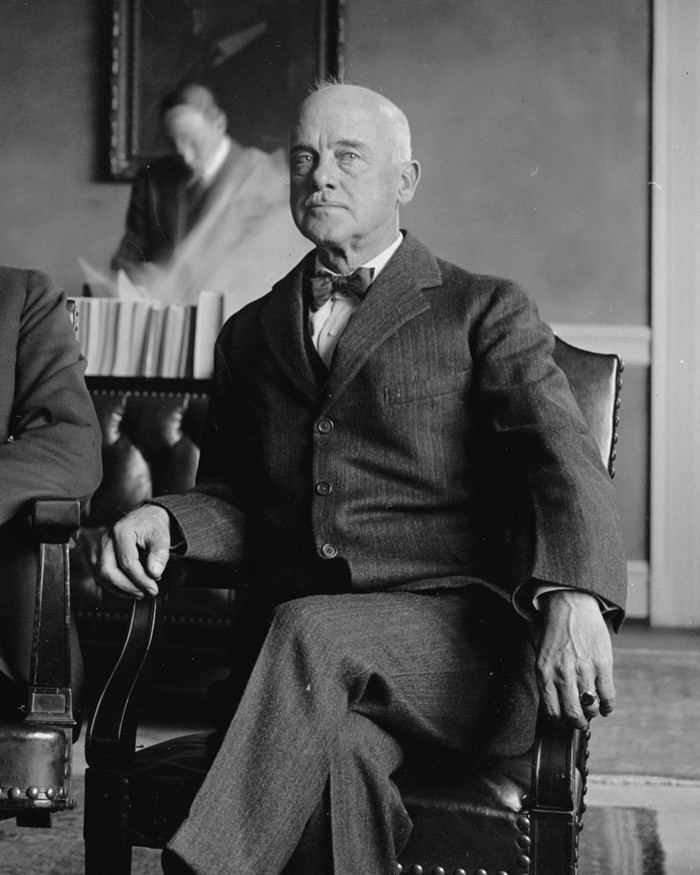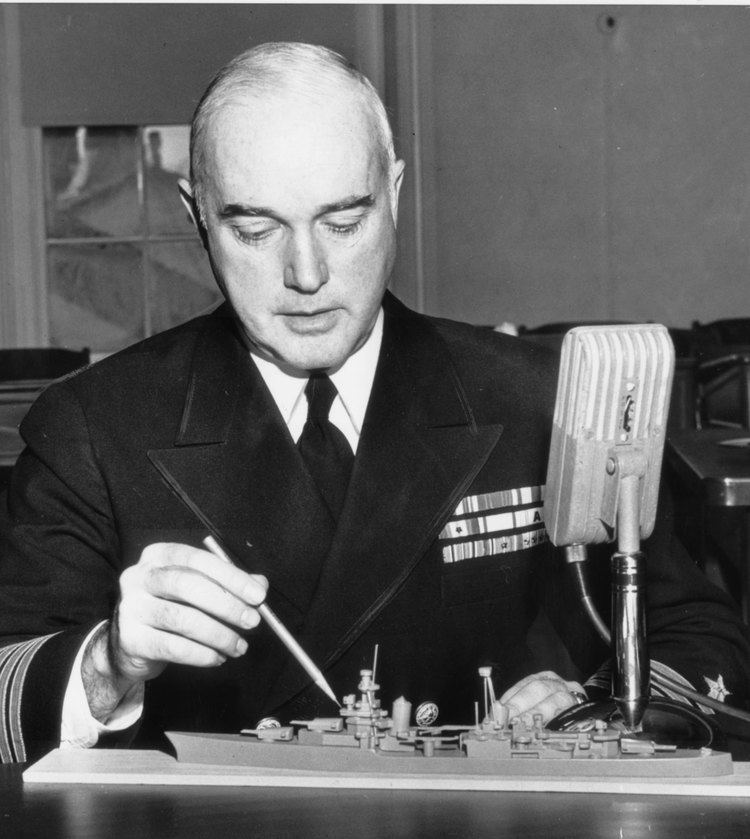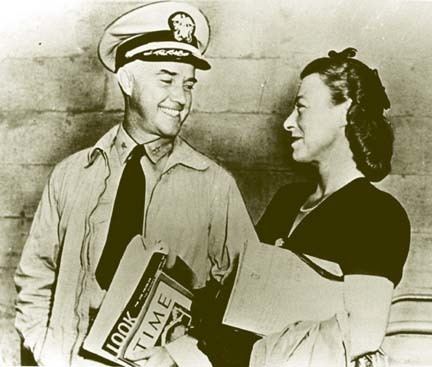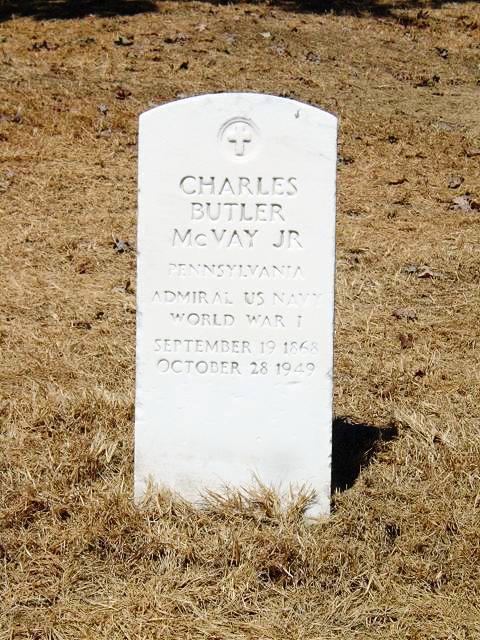Years of service 1920–1949 Children Kimo Wilder McVay | Name Charles McVay Rank Rear Admiral | |
 | ||
Full name Charles B. McVay III Born July 30, 1898Ephrata, Pennsylvania ( 1898-07-30 ) Place of burial Bayou Liberty, Louisiana Allegiance United States of America Commands held USS Indianapolis (CA-35) Battles/wars World War IIBattle of Iwo JimaBattle of OkinawaSinking of the USS Indianapolis Battles and wars | ||
McVay
Charles B. McVay III (July 30, 1898 – November 6, 1968) was an American naval officer and the commanding officer of USS Indianapolis (CA-35) when it was lost in action in 1945, resulting in a massive loss of life. Of all captains in the history of the United States Navy, he is the only one to have been subjected to court-martial for losing a ship sunk by an act of war, despite the fact that he was on a top secret mission maintaining radio silence (the testimony of the Japanese commander who sank his ship also seemed to exonerate McVay). After years of mental health problems, he committed suicide. Following years of efforts by some survivors and others to clear his name, McVay was posthumously exonerated by the 106th United States Congress and President Bill Clinton on October 30, 2000.
Contents
- McVay
- Education and career
- Sinking of Indianapolis
- Delayed rescue
- Controversy
- Suicide
- Exoneration
- In popular culture
- References

Education and career

Charles Butler McVay III was born in Ephrata, Pennsylvania on July 30, 1898 to a Navy family. His father, Charles Butler McVay Jr. (September 9, 1868 – October 28, 1949), who had commanded the tender Yankton during the cruise of the Great White Fleet (1907–1909), was an admiral in the United States Navy during World War I, and served as Commander-in-Chief of the Asiatic Fleet the early 1930s.

Charles III was a 1920 graduate of the United States Naval Academy at Annapolis, Maryland. Before taking command of Indianapolis in November 1944, McVay was chairman of the Joint Intelligence Committee of the Combined Chiefs of Staff in Washington, D.C., the Allies' highest intelligence unit. Earlier in World War II, he was awarded the Silver Star for displaying courage under fire.

McVay led the ship through the invasion of Iwo Jima, then the bombardment of Okinawa in the spring of 1945, during which Indianapolis anti-aircraft guns shot down seven enemy planes before the ship was struck by a kamikaze on March 31, inflicting heavy casualties, including 13 dead, and penetrating the ship's hull. McVay returned the ship safely to Mare Island in California for repairs.
Sinking of Indianapolis
Later that year, Indianapolis received orders to carry parts and nuclear material to Tinian to be used in the atomic bombs which were soon to be dropped on Hiroshima and Nagasaki. After delivering his top secret cargo, the ship was en route to report for further duty off Okinawa.
Early in the morning of July 30, 1945, she was attacked by the Japanese submarine I-58 under Commander Mochitsura Hashimoto. Hashimoto launched six torpedoes and hit Indianapolis twice, the first removing over forty feet of her bow, the second hitting the starboard side at frame forty (below the bridge). Indianapolis immediately took a fifteen degree list, capsized and sank within 12 minutes. Of the crew of 1,196 men, 879 men died.
Delayed rescue
About 300 of the 1,196 men on board died in the initial attack. The rest of the crew, 900 men, were left floating in the water without lifeboats until the rescue was completed four days (100 hours) later. Because of Navy protocol regarding secret missions, the ship was not reported "overdue" and the rescue came only after survivors were spotted by pilot Lieutenant Wilber (Chuck) Gwinn and co-pilot Lieutenant Warren Colwell on a routine patrol flight. It has been part of folklore that most of the casualties of the survivors in the water were due to shark attacks; however, most died from injuries sustained aboard the ship, dehydration, exhaustion, and the result of drinking salt water. The seas had been moderate, but visibility was not good. Indianapolis had been steaming at 15.7 knots (29 km/h). When the ship did not reach Leyte on the 31st, as scheduled, no report was made that she was overdue. This omission was officially recorded later as "due to a misunderstanding of the Movement Report System".
Controversy
McVay was wounded but survived and was among those rescued. He repeatedly asked the Navy why it took five days to rescue his men, and he never received an answer. The Navy long claimed that SOS messages were never received because the ship was operating under a policy of radio silence; declassified records show that three SOS messages were received separately, but none were acted upon because one commander thought it was a Japanese ruse, another had given orders not to be disturbed, and a third was drunk.
After a Navy Court of Inquiry recommended that McVay be court-martialed for the loss of Indianapolis, Admiral Chester Nimitz disagreed and instead issued the captain a letter of reprimand. Admiral Ernest King overturned Nimitz’s decision and recommended a court-martial, which Secretary of the Navy James Forrestal later convened. McVay was charged with failing to zigzag and failure to order abandon ship in a timely manner. He was convicted on the former. Prior knowledge of Japanese submarines being identified in the area was withheld from the court and from McVay, prior to sailing, as well. Following McVay's conviction for hazarding Indianapolis by failing to zigzag, Admiral King recommended setting aside the punishment. Hashimoto, the Japanese submarine commander who had sunk the Indianapolis, was on record as describing visibility at the time as fair (which is corroborated by the fact that he was able to target and sink the Indianapolis in the first place). American submarine experts testified that "zigzagging" was a technique of negligible value in eluding enemy submarines. Hashimoto also testified to this effect. Despite that testimony, the official ruling was that visibility was good, and the court held McVay responsible for failing to zigzag.
An additional point of controversy is evidence that the admirals in the United States Navy were primarily responsible for placing the ship in harm's way. For instance, McVay requested a destroyer escort for the Indianapolis, but his request was denied because the priority for destroyers at the time was escorting transports to Okinawa, and picking up downed pilots in B-29 raids on Japan. Also, naval command assumed McVay's route would be safe at that point in the war. Many ships, including most destroyers, were equipped with submarine detection equipment, but the Indianapolis was not so equipped, which casts the decision to deny McVay's request for an escort as a tragic mistake.
On 24 July 1945, just six days prior to the sinking of the Indianapolis, the destroyer Underhill had been attacked and sunk in the area by Japanese submarines. Yet McVay was never informed of this event, and several others, in part due to issues of classified intelligence. McVay was warned of the potential presence of Japanese subs, but not of the actual confirmed activity.
Although about 380 ships of the U.S. Navy were lost in combat in World War II, McVay was the only captain to be court-martialed for the loss of his ship. It was widely felt that he had been a fall guy for the Navy. The conviction effectively ended McVay's career as he lost seniority, although the sentence was overturned by Secretary James Forrestal owing to McVay's bravery prior to the sinking, and he was finally promoted to rear admiral when he retired from the navy in 1949, although he apparently never got over his treatment.
In his book Abandon Ship, author Richard F. Newcomb posits a motive for Admiral King's ordering McVay's court-martial. According to Captain McVay III's father, Admiral Charles B McVay Jr, "'King never forgot a grudge," he exploded. King had been a junior officer under the old man's command when King and other officers sneaked some women aboard a ship. Admiral McVay had a letter of reprimand placed in King's record. "Now," he raged, "King's used you to get back at me.'"
Suicide
On 6 November 1968, McVay committed suicide by shooting himself with his service pistol at his home in Litchfield, Connecticut, holding in his hand a toy sailor he had received as a boy for a good luck charm. He was found in his front yard by his gardener. Though a note was not left, McVay was known by those close to him to have suffered from loneliness, particularly after losing his wife to cancer. McVay also struggled throughout his life from vicious letters and phone calls he periodically received from grief-stricken relatives of dead crewmen who served aboard the Indianapolis.
Exoneration
USS Indianapolis survivors organized, and many spent years attempting to clear their skipper's name. Many people, from McVay's son Charles McVay IV (1925–2012) to author Dan Kurzman, who chronicled the Indianapolis incident in Fatal Voyage, to members of Congress, long believed McVay was unfairly convicted. Paul Murphy, president of the USS Indianapolis Survivors Organization, said: "Captain McVay's court-martial was simply to divert attention from the terrible loss of life caused by procedural mistakes which never alerted anyone that we were missing."
Over fifty years after the incident, a 12-year-old student in Pensacola, Florida, Hunter Scott, was instrumental in raising awareness of the miscarriage of justice carried out at the captain's court-martial. As part of a school project for the National History Day program, the young man interviewed nearly 150 survivors of the Indianapolis sinking and reviewed 800 documents. His testimony before the U.S. Congress brought national attention to the situation.
In October 2000, the United States Congress passed a resolution that McVay's record should reflect that "he is exonerated for the loss of the USS Indianapolis." President Clinton also signed the resolution. Commander Hashimoto died five days before the exoneration (on 25 October).
In July 2001, Secretary of the Navy Gordon R. England ordered McVay's official Navy record purged of all wrongdoing.
In popular culture
McVay's ship, but not McVay himself, is mentioned in the 1975 blockbuster movie Jaws, in which the character of Quint is portrayed as a survivor of the incident.
In 1978, the events surrounding McVay's court-martial were dramatized in The Failure to ZigZag by playwright John B. Ferzacca. The 1991 made-for-television movie Mission of the Shark: The Saga of the U.S.S. Indianapolis depicts the ordeal of the men of the Indianapolis during her last voyage (with McVay portrayed by Stacy Keach), as does the 2016 film USS Indianapolis: Men of Courage (with McVay portrayed by Nicolas Cage). Also in 2016, USS Indianapolis: The Legacy was released. It is an in-depth film where the survivors tell the story of what really happened and they speak about the aftermath of the tragic event.
